Dr. Fan Liangdong's research group from the School of Chemistry and Environmental Engineering, Shenzhen University, has made progress in the research direction of solid oxide fuel cells and electrolytic cells (electrolysis of CO2). The relevant research results have been published in Nano Energy, Electrochemical Energy Review, Small, Science China Materials, ACS Applied Materials & Interfaces, Journal of Power Sources, and so on.
With the rapid development of modern society, the energy demand is increasing day by day. The excessive use of traditional fuels has caused a large amount of greenhouse gas, like carbon dioxide (CO2), emissions. New energy sources such as solar energy and wind energy are limited by their instability and other issues. Using the excess electricity of new energy to convert CO2 into other combustible gases is an effective solution for making full use of new energy and reducing emissions. Solid oxide electrolysis cells (SOECs) have attracted the attention of many researchers and have been applied in the electrolysis of CO2, due to their high conversion efficiency and favorable thermodynamic conditions. The research paper titled "Enhancing Electrochemical CO2 Reduction on Perovskite Oxide for Solid Oxide Electrolysis Cells through In Situ A-Site Deficiencies and Surface Carbonate Deposition Induced by Lithium Cation Doping and Exsolution" was recently published in the international journal Small (impact factor 15.153) by postgraduate student Lin Wanbin, and co-author Dr. Fan as main corresponding author. This work reports a method to improve the performance of catalytic reduction of CO2 by lithium modifying the perovskite La0.55Li0.05Sr0.4Co0.7Mn0.3O3-δ. The experimental and theoretical calculation results prove that the doping of Li can increase the oxygen vacancy concentration of the material and change the chemical environment of B-site ions. At the same time, lithium carbonate formed by the in-situ exsolution of Li in a high-temperature CO2 environment can serve as a new catalytic adsorption site for CO2, helping the adsorption and activation of carbon dioxide. The assembled SOEC cell La0.55Li0.05Sr0.4Co0.7Mn0.3O3-δ|LSGM|LSCF at 800 oC, 1.5V with pure CO2 showed improved performance over that of the undoped unmodified electrolytic cell, close to 30%, and the electrolytic cell can run stably for more than 300 hours. The results confirm that lithium doping is a feasible new strategy to enhance the CO2 catalytic performance of perovskite oxide cathodes.
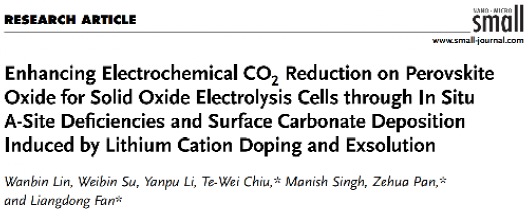
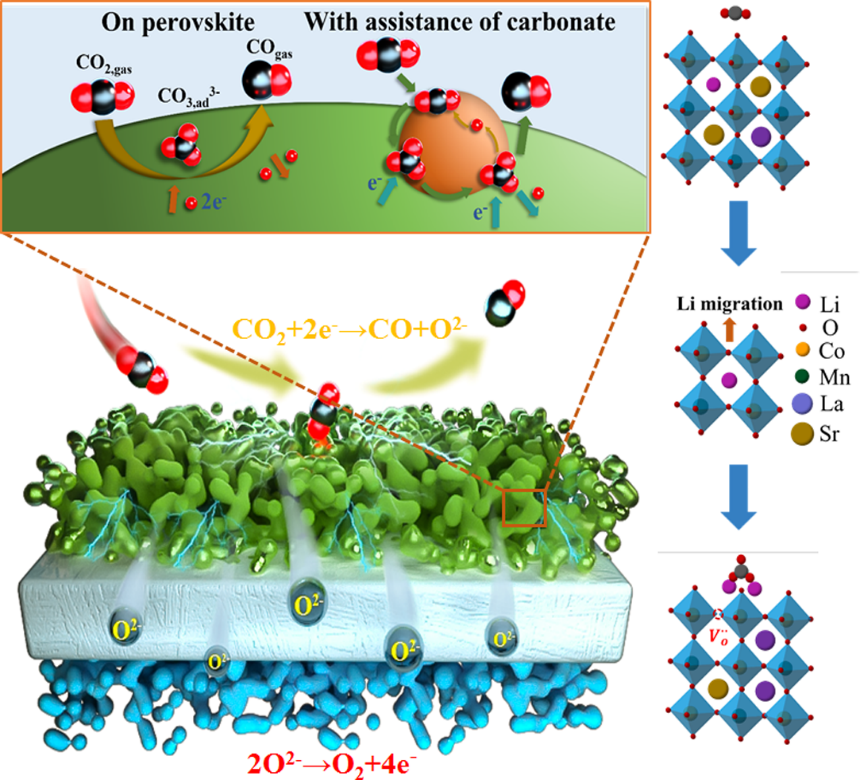
Full-text link: https://doi.org/10.1002/smll.202303305
The research paper entitled "Efficient reversible CO/CO2 conversion in solid oxide cells with a phase-transformed fuel electrode phase-change fuel electrode realizes efficient and reversible CO/CO2 conversion in solid oxide cells" is led by Li Yihang and Prof. Fan at Shenzhen University and was published in the international journal Science China-Materials (China Science Series - the flagship journal in materials science, impact factor 8.64) and has been cited 19 times so far.
Reversible solid oxide cells (RSOC) have high energy conversion efficiency. On the same device, fuels such as CO can be fully converted into electrical energy without being limited by the Carnot cycle, and the Faraday efficiency is close to 100% and CO2 can be converted into CO and other fuels and stored renewable energy electricity to chemical energy. This work proposes a nanostructured perovskite Sr2Fe7/6Mo0.5Co1/3O6−δ (SFMCo) that can be transformed into a Ruddlesden-Popper phase perovskite Sr3Fe1.25Mo0.75O7−δ and CoFe alloy two-phase composite material under hydrogen reduction conditions. Benefited from the two-phase heterostructure effect and the strong catalytic effect of CoFe alloy, the assembled single cell SFMCo/SDC//YSZ//LSM-SDC operated at 800 oC and 2 :1 CO-CO2 has the highest discharge power density of 259 mW cm−2, an electrolysis current of −0.453 A cm−2 at a voltage of 1.3V, and its reversible operation between 0.6V (solid oxide fuel cell mode, SOFC) and 1.3V (SOEC mode) for 20 times remains stable. This work also systematically studies the reaction kinetics of CO2 reduction and CO oxidation and determines the relevant rate-controlling steps. This work provides guidance and assistance for the design of reversible solid oxide cell electrodes for efficient conversion and utilization of CO2 in the future.
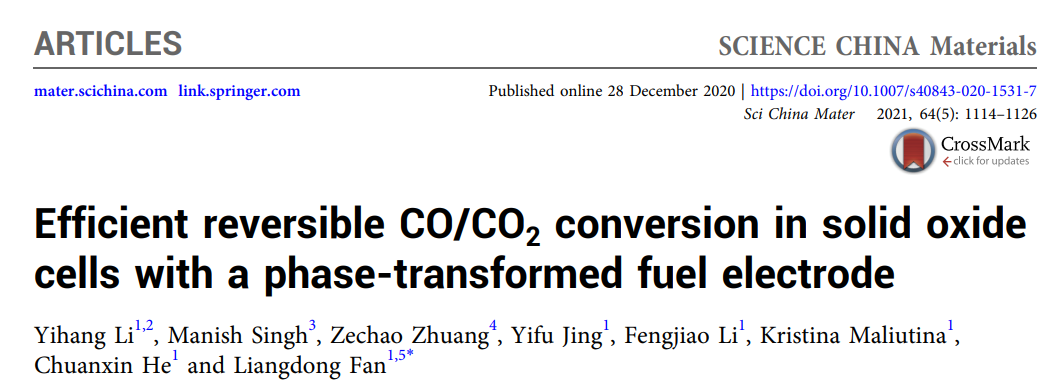
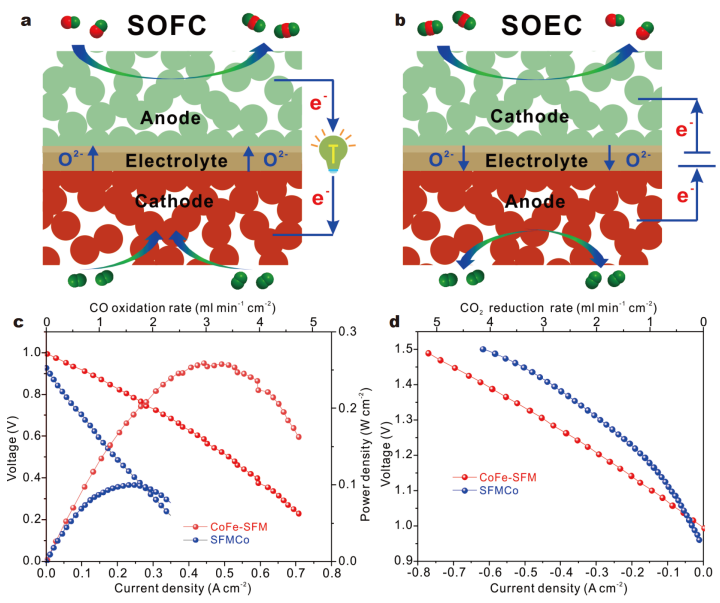
Full-text link: https://doi.org/10.1007/s40843-020-1531-7
Based on the above work, Dr. Fan’s research group epitaxially grew NiFe alloy on the surface of perovskite oxide for efficient and reversible CO2/CO conversion in reversible solid oxide cells. The research paper entitled "Mutual Conversion of CO–CO2 on a Perovskite Fuel Electrode with Endogenous Alloy Nanoparticles for Reversible Solid Oxide Cells" was published in the international journal ACS Applied Materials & Interfaces, and it has been cited 31 times so far. The paper was led by Li Yihang and Dr. Fan of Shenzhen University. This work reports the material Sr1.97Fe1.5Mo0.5Ni0.1O6−δ (SFMN). The assembled SFMN/ /SDC//LSGM//LSCF-SDC single cell achieved the highest power density of 443 mW cm−2 and current density of -0.877 A cm−2 (1.46V) at 800 oC under fuel cell, and electrolytic cell modes, respectively. The performance of SFMN is superior to that of the original material Sr2Fe1.5Mo0.5O6−δ and the traditional Ni-YSZ electrode. Moreover, it exhibits excellent anti-coking potential and realizes stable operation of 20 cycles of reversible SOFC/SOEC within 40 hours. Hence, this work provides a feasible scheme to design highly active and stable fuel electrodes for reversible solid oxide cells.

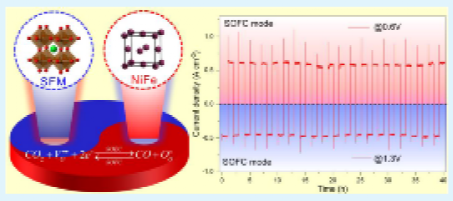
Full-text link: https://doi.org/10.1021/acsami.1c23548
Dr. Fan's group designed and synthesized a composite electrode catalyst to improve the catalytic conversion ability of CO2 since it is difficult for single-phase catalytic materials to achieve efficient and multi-step catalytic conversion for the CO2 reduction process. The research paper titled "Achieving excellent and durable CO2 electrolysis performance on a dual-phase fuel electrode in solid oxide electrolysis cells" by Li Yihang, a postdoctoral fellow of Shenzhen University, Li Yanpu, a graduate student of class 2020, and Dr. Fan as the corresponding author from Shenzhen University, reports the one-pot synthesis of a nominal composition of Pr0.2Ca0.8Fe0.8Ni0.2O3 achieved by the self-assembly method. This composite material contains perovskite Pr(Ca)Fe(Ni)O3-δ and andorite Ca2Fe2O5 two-phase material. Thanks to the high oxygen vacancy concentration of Ca2Fe2O5 and the composite effect of two-phase materials, it exhibits a much higher surface chemical exchange coefficient (1.104×10−4 cm−1 at 800 oC) than conventional perovskite materials due to the strong CO2 adsorption capacity. The assembled electrolytic cell Pr(Ca)Fe(Ni)O3-δ-Ca2Fe2O5//LSGM//LSCF achieved a density current of 0.648 Acm−2 at 800 oC/1.5V, and maintained stability for nearly 300 h in the variable temperature and load simulated electrolytic CO2 test. Therefore, the self-assembly approach provides new strategies for the design and synthesis of composite electrode materials. The paper was published in the international journal Journal of Power Sources (impact factor 9.794) and has been cited 16 times so far.
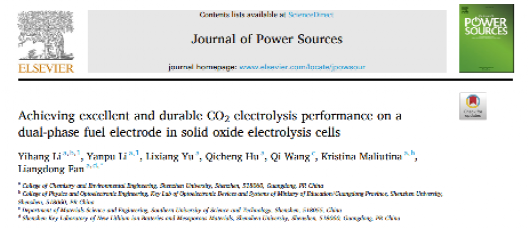
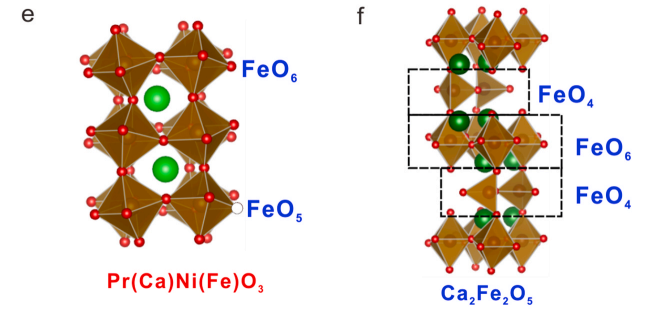
Full-text link: https://doi.org/10.1016/j.jpowsour.2021.229599
The paper entitled "Approaching Durable Single-Layer Fuel Cells: Promotion of Electroactivity and Charge Separation via Nanoalloy Redox Exsolution" was published in the international journal ACS Applied Materials & Interfaces (impact factor 9.229). Co-authored by Prof. Dr. Fan and master student Shao Kang, with Shenzhen University as the first author affiliation and sole correspondent, this work has been cited 61 times so far. Fan's research group used the metal/oxide-perovskite oxide composite materials, constructed by epitaxial growth, for new ceramic fuel cells, also known as single-layer fuel cells or semiconductor-ion fuel cells. This work takes advantage of the stable redox structure of the perovskite material itself and combines it with the in situ exsolution of metal nanoparticles to construct a metal-perovskite semiconductor heterojunction. The latter achieved the effect of "killing two birds with one stone" in an efficient and stable fuel cell by improving the catalytic oxygen reduction and hydrogen oxidation reaction rates while constructing a generalized scale p-n junction and Schottky junction. The latter effectively alleviates the internal short circuit problem of the semiconductor "electrolyte", stabilizes the performance of the single cell to a certain extent, and achieves efficient and stable fuel cells. This work provides a methodological reference for the efficiency and stable operation of novel fuel cells and for understanding their corresponding working principles. Based on this work, Wang Zenghui, a postgraduate student of the research group, and Dr. Meng Yuanjing as the co-first authors, and Dr. Fan as the corresponding author, published a paper on "Ni/NiO exsolved perovskite La0.2Sr0.7Ti0.9Ni0.1O3−δ for semiconductor-ionic fuel cells: Roles of electrocatalytic activity and physical junctions" on ACS Applied Materials & Interfaces (Impact factor 10.383). In this work, an extra-functional catalytic layer was added to the anode, combined with feasible perovskite surface stripping and functional catalytic energy reduction to construct a metal-perovskite semiconductor heterojunction from the microscopic and macroscopic (bulk) scales. This significantly improved the catalytic performance and charge separation efficiency, resulting in a maximum power density of the corresponding semiconductor ion fuel cell that is more than an order of magnitude higher than that of the unmodified cell.
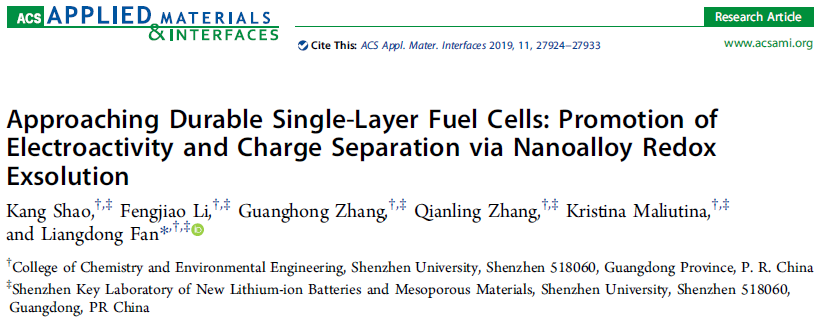
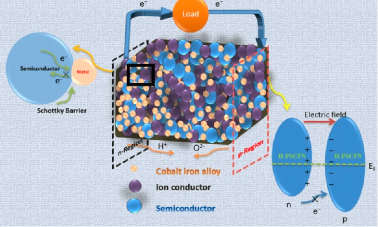
Full-text link: https://doi.org/10.1021/acsami.9b08448
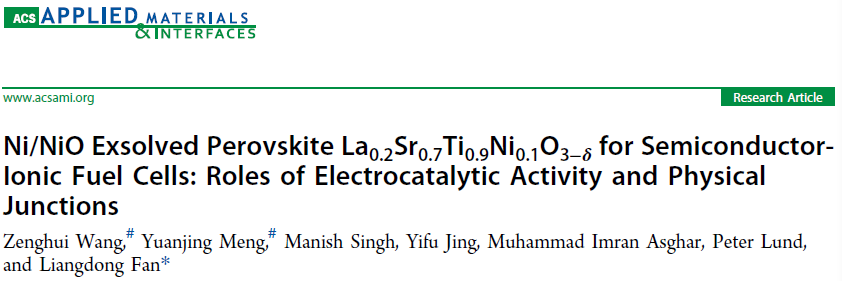
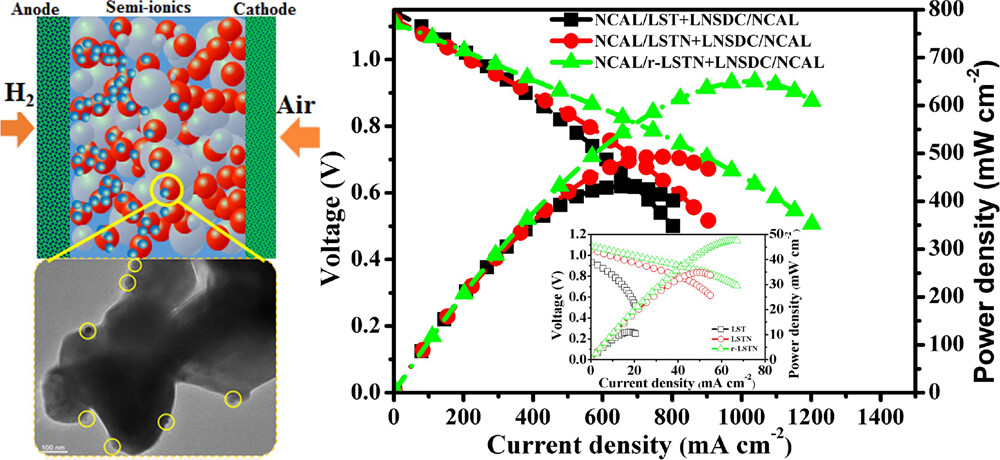
Full-text link: https://doi.org/10.1021/acsami.2c16002
In addition, Prof. Fan's research group also cooperated with the research group of Professor Zhu Bin from the Swedish Royal Institute of Technology/Southeast University, Professor Su Pei-Chen from Nanyang Technological University in Singapore, Professor Rizwan Raza from COMSATS University Islamabad in Pakistan, and Professor Yun Sining from Xi'an University of Architecture and Technology, and published two review works titled "Nanomaterials and technologies for low temperature solid oxide fuel cells: Recent advances, challenges and opportunities" in Nano Energy (Impact Factor: 15.548) and and "Semiconductor Electrochemistry for Clean Energy Conversion and Storage" in Electrochemical Energy Reviews (Impact Factor: 32.804. In these works, an in-depth literature survey, review, summary, and outlook on the latest research progress of nanomaterials and processes, semiconductor electrochemistry in the direction of solid oxide fuel cells was performed and the challenges faced by related technologies are discussed and the possible solution with authored opinions was provided. Particularly, Nano Energy review work has been non-self-citation cited by over 260 times and is considered an EIS highly cited paper (1%); it was also selected as an ESI hot paper (1‰).
Full-text link: https://doi.org/10.1016/j.nanoen.2017.12.044
https://doi.org/10.1007/s41918-021-00112-8
The above research works are funded by the National Natural Science Foundation of China, the Natural Science Foundation of the Guangdong Province (Department of Science and Technology), the University Research Project of the Education Department of Guangdong Province, the general project of the Shenzhen Science and Technology Innovation Commission, and the Shenzhen University-Taipei University of Technology joint research project.
